
Nicolai Abraham Abildgaard was a Danish neoclassical and royal history painter, sculptor, architect, and professor of painting, mythology, and anatomy at the New Royal Danish Academy of Art in Copenhagen, Denmark. Many of his works were in the royal Christiansborg Palace, Fredensborg Palace, and Levetzau Palace at Amalienborg.
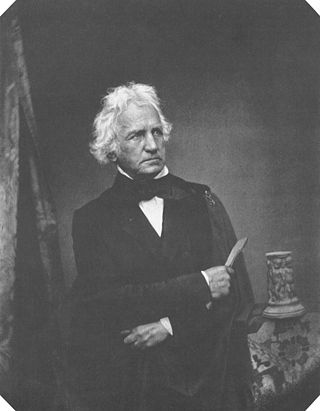
Christian Daniel Rauch was a German sculptor. He founded the Berlin school of sculpture, and was the foremost German sculptor of the 19th century.

Christiansborg Palace is a palace and government building on the islet of Slotsholmen in central Copenhagen, Denmark. It is the seat of the Danish Parliament, the Danish Prime Minister's Office, and the Supreme Court of Denmark. Also, several parts of the palace are used by the Danish monarch, including the Royal Reception Rooms, the Palace Chapel and the Royal Stables.

Johannes Wiedewelt, Danish neoclassical sculptor. He became a court sculptor, introducing neoclassical ideals to Denmark in the form of palace decorations, garden sculptures and artifacts and, especially, memorial monuments. He was undoubtedly the best known Danish sculptor before Bertel Thorvaldsen.

Jacques François Joseph Saly, also known as Jacques Saly, French-born sculptor who worked in France, Italy and Malta. He is commonly associated with his time in Denmark he served as Director of the Royal Danish Academy of Art (1754–71). His most noteworthy work is the equestrian statue Frederik V on Horseback at Amalienborg.
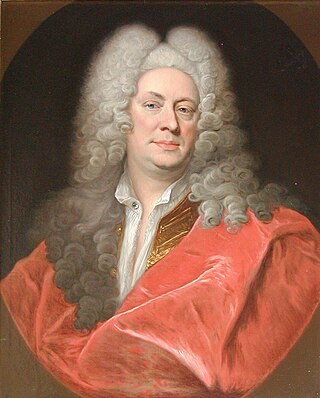
Hendrick Krock was a Danish history painter who, from 1706, was the court painter of Frederick IV as well as his successor Christian VI. Along with Benoit Le Coffre set the tone for history painting in Denmark during the 18th century-1720s, having been influenced by the Italian baroque painting he experienced during his travels. He also played a role in the eventual establishment of an Art Academy in Denmark.

Nicolas-Henri Jardin was a French architect. Born in St. Germain des Noyers, Seine-et-Marne, Jardin worked seventeen years in Denmark–Norway as an architect to the Danish royal court. He introduced neoclassicism to Denmark–Norway.
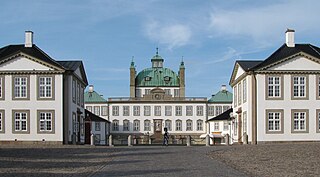
Fredensborg Palace is a palace located on the eastern shore of Lake Esrum in Fredensborg on the island of Zealand (Sjælland) in Denmark. It is the Danish royal family’s spring and autumn residence, and is often the site of important state visits and events in the royal family. It is the most used of the royal family’s residences.

St. Peter's Church is the parish church of the German-speaking community in Copenhagen, Denmark. It is situated at the corner of Nørregade and Sankt Peders Stræde in the city's Latin Quarter. Built as a single-nave church in the mid-15th century, it is the oldest building in central Copenhagen. It is also notable for its extensive complex of sepulchral chapels.
Philip de Lange was a leading Dutch-Danish architect who designed many different types of building in various styles including Dutch Baroque and Rococo.

Johan Martin Quist or Qvist was a Danish architect who made a significant contribution to the city of Copenhagen. Together with those of Andreas Hallander, his classically styled buildings form part of the legacy of 19th-century Danish Golden Age architects who reconstructed areas of the old town which had been destroyed in the Copenhagen Fire of 1795.

Jacob Fortling was a German-Danish sculptor, architect and industrialist, described as one of the most industrious people in the Denmark of his day. He came to Denmark at age 18 and embarked on a successful career, first as a sculptor and later also as an architect. He was also engaged in the production of building materials, owning several quarries in Norway. Just outside Copenhagen, on Amager's east coast, he founded Kastrup Værk, a large industrial facility combining a lime plant, a brickyard and a pottery.
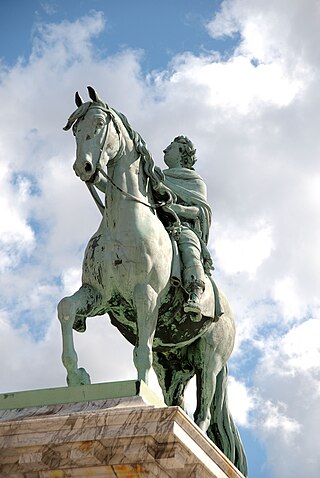
Danish sculpture as a nationally recognized art form can be traced back to 1752 when Jacques Saly was commissioned to execute a statue of King Frederick V of Denmark on horseback. While Bertel Thorvaldsen was undoubtedly the country's most prominent contributor, many other players have produced fine work, especially in the areas of Neoclassicism, Realism, and in Historicism, the latter resulting from growing consciousness of a national identity. More recently, Danish sculpture has been inspired by European trends, especially those from Paris, including Surrealism and Modernism.

Johan Christoph Petzold was a German sculptor who mainly worked in Denmark. He was a professor at the Royal Danish Academy of Fine Arts from its establishment in 1754 and briefly held the post of Sculptor to the Danish Court.

An equestrian statue of King Frederick V of Denmark stands in the center of Amalienborg Square, Copenhagen, framed by the four symmetrical wings of the Amalienborg palace. The statue portrays the king in classic attire, crowned with laurels and with his hand outstretched, holding a baton. Commissioned by the Danish East India Company, it was designed in Neoclassical style by Jacques Saly in 1768 and was cast in bronze in 1771. The apparent dignity and tranquility in the depiction of the king is typical of Danish representations of monarchs. It is considered to be one of the notable equestrian monuments of its time.
Grund is a German and Scandinavian surname. Notable people with the surname include:

Ved Stranden 8 is a Neoclassical property located at the corner of Ved Stranden and Boldhusgade, opposite Christiansborg Palace, in central Copenhagen, Denmark. The building was listed on the Danish registry of protected buildings and places in 1932.
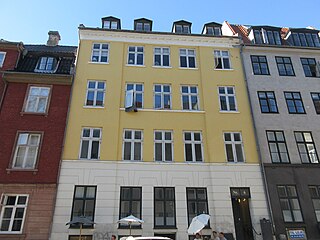
Boldhusgade 6 is a Neoclassical property off the Ved Stranden canalfront in central Copenhagen, Denmark. The building was like most of the other buildings in the area constructed in the years after the Copenhagen Fire of 1795. It was listed in the Danish registry of protected buildings and places in 1959.

Admiralgade 23 is a Neoclassical property situated at the corner of Admiralgade and Dybensgade in central Copenhagen, Denmark. It was together with the adjacent building at Dybensgade 21 constructed for goldsmith Christian Nielsen Lindbach after the previous buildings at the site had been destroyed in the Copenhagen Fire of 1795. The two properties were merged into a single property in 1981. They were jointly listed in the Danish registry of protected buildings and places in 1945.





















